|
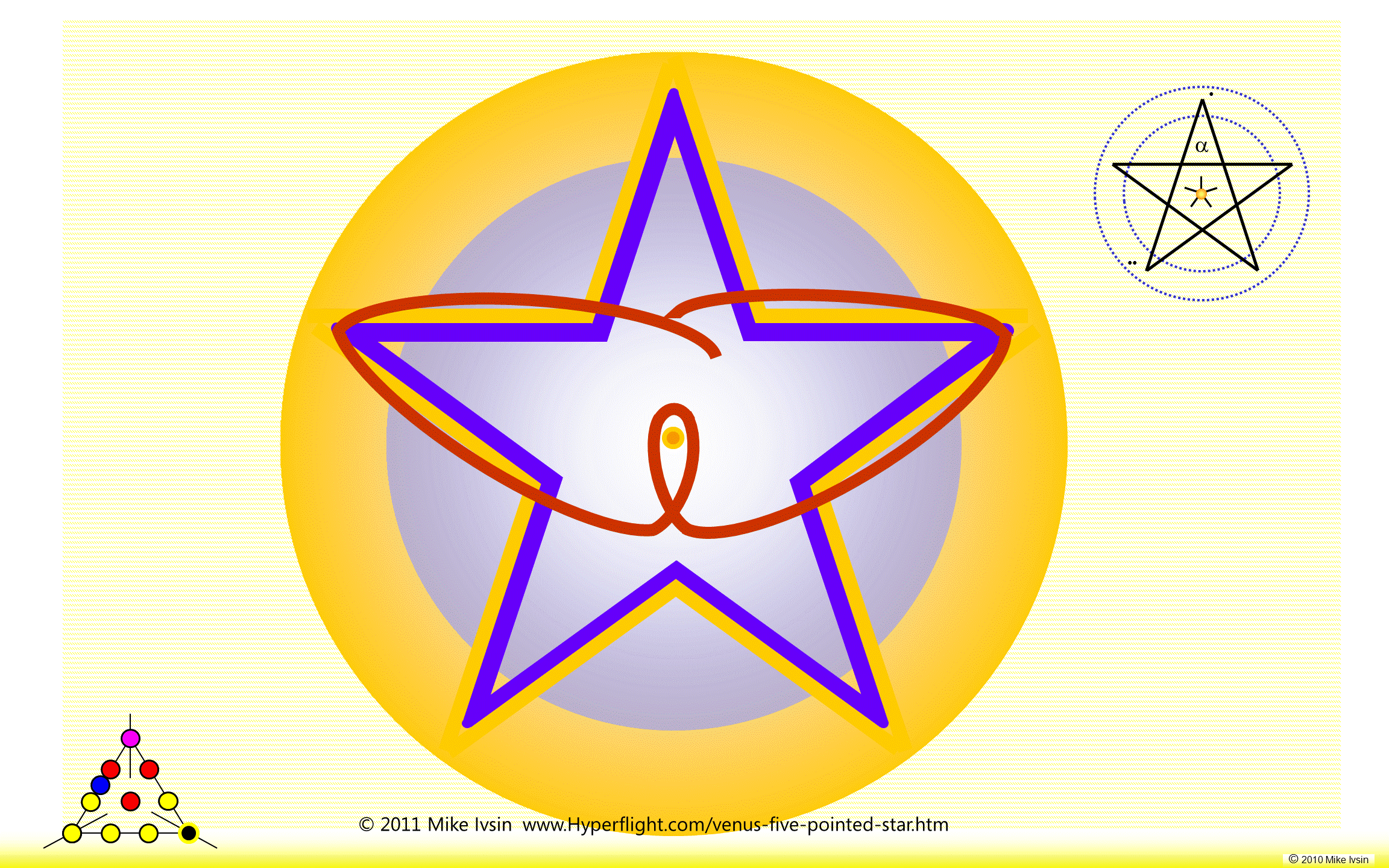 Two
pointed star of Neptune-Pluto joins the
five point star — there is Catseye looking
at you, kid Two
pointed star of Neptune-Pluto joins the
five point star — there is Catseye looking
at you, kid
Eight
pointed star chimes in —
the eight sided octagon is from Mars and it is musical, you know,
even though it is filled in counterclockwise
Note
on the occult —
cannot see it but you can figure it out
Intro
There
are many stars and you can draw them with the number of points of
your choosing. The first star has five points and it certainly is in
the heavens if heavens is what you see above when you look up at
night. The shape of this five point star is crafted together by Venus
and Earth. |
|
Orbit ratios. Mayan
astronomers
first observed, measured, and applied the periodic relationship
between the planet Venus and Earth. It turns out these two bodies
have interlocked orbits in a ratio and that means that the planetary
orbits of Venus and Earth are not independent of each other. |
 Mayan
stargazer. For better or for worse, Mayan
Venus horoscope dealt with propitious times to wage war. Mayan
stargazer. For better or for worse, Mayan
Venus horoscope dealt with propitious times to wage war. |
|
The ratio is very
close to 8:5 -- for every eight Venus orbits (cycles), our Earth
completes five orbits (years). While this is not a source of orbit
problems, the orbit's fixed ratio (interlock) allows Venus and Earth
to become effectively a single
planet
in one orbit. The resulting merged planet is moving close to the
midpoint between Venus and Earth because both of these planets are of
about the same size (have about the same mass). From the Sun's point
of view the positions of both Venus and Earth periodically occupy the
same two spots on the solar plane and the merged planet is then also
in a spot it occupied before. Every time Venus catches up with Earth
the merged planet reaches its aphelion, the farthest distance from
the center of the Sun. For such merged planet the time between
aphelions happens every 1.6 earth years. The interlock of the two
orbits merges both planets yielding one highly elliptical orbit that
rotates and repeats every eight years -- that is, the merged planet
passes the same starting point every eight years while its path is
curved. During these eight years the merged planet reaches aphelion
five times, tracing a star with five points and taking 1.6 years
between points.
Historically, the
aphelion is defined as the farthest distance from the Sun but you may
have noticed that the aphelion for the merged Venus-Earth planet is
now defined as the farthest distance from the center of the Sun. The
merged planet's orbit may possibly dip into the Sun.
You can imagine
the crisis in the horoscope circles as Galileo's
and Newton telescopes begin to
uncover new planets. There were seven planetary influences and seven
is a sacred number. Horoscope casting is a serious business for some,
so what is to be done? Presently, several mainstream science
publications want to make Pluto a planetary outcast but nobody is
arguing whether Venus or Earth is a planet or not. We could never
think of Earth as not being a bona fide planet -- yet the Sun has
made the orbital decision for us. Sun sees Venus and Earth as one
body that orbits in a five pointed star topology with a tight
curlicue approaching the Sun between points. Perhaps there is a way
to resolve all of this because Pluto's orbit is interlocked with
Neptune as well. So now, planetary pairs merge computationally
and each pair forms a unique orbit. While it may be difficult to
prove that seven is the maximum number of independent orbits in our
solar system, what this also means is that there could be more
planets than there are independent orbits.
Why not give each
planet its own independent orbit? There may come a point where this
is not possible. Any two-body
system is tractable
but a three-body system can become chaotic and intractable. An
independent orbit calls for planetary separation that is great enough
for each planet to be treated as a two-body sun-planet system. As big
as Sun's mass is, there are but a limited number of orbits available.
Orbit interlock allows merging of Venus and Earth such that the two
bodies become one and the resulting body is always tractable with
respect to Sun. A potential Sun-Venus-Earth chaotic trio becomes a
tractable duo. Giving Venus and Earth their own independent orbit
could technically result in two two-body systems but would likely
require greater planetary separation and greater distance from the
Sun. Also, the orbital interlock of Venus-Earth, say, could results
in a smaller disturbance or wobble onto the Sun: Through the
orbit interlock both bodies can be physically closer to the Sun and
to each other.
Tracing the
merged pair of planets. Now, take the Venus and Earth planets as
orbiting in the clockwise direction and start both planets at the
top. The merged planet makes its first aphelion also at the top,
which is the merged planet's first aphelion (point). As planets
orbit, the merged planet skips every two points of a five pointed
star because the the next time Venus and Earth are closest together
is at the fourth point. The trace of aphelions moves from first (top)
to fourth to second to fifth to third and back to the first point.
The illustration of the merged planet trace is further down. [You may
find a bit more in the illustration
than just a trace -- give it a slight tilt.]
Being in the solar
plane the star’s orientation does not have an appreciable social
aspect, at least as far as the solar perspective is concerned. The
five pointed star of this pentacle is intimately related to Venus and Earth.
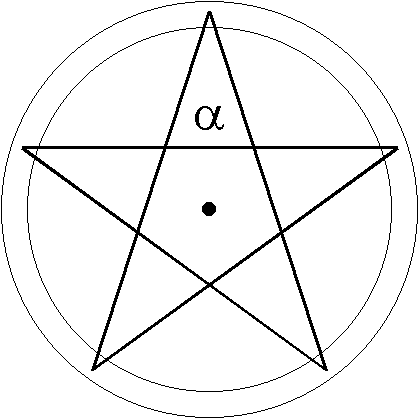
Five pointed star:
Pentacle with two rings -- that is, orbits (not to scale) |
|
Planet is a planet
because it contributes to the solar system's angular momentum through
its own angular (orbit) velocity. Angular mo is
the rotation energy (of a spinning bullet, say) that contributes to
the solar system's stability. Because the angular momentum is
proportional to the radius squared, the angular mo of Pluto, for
example, exceeds those of the terrestrial planets, Earth included.
For a treatment of the angular momentum on both the cosmic and atomic
(electron) scales, visit ConceptThree. |
|
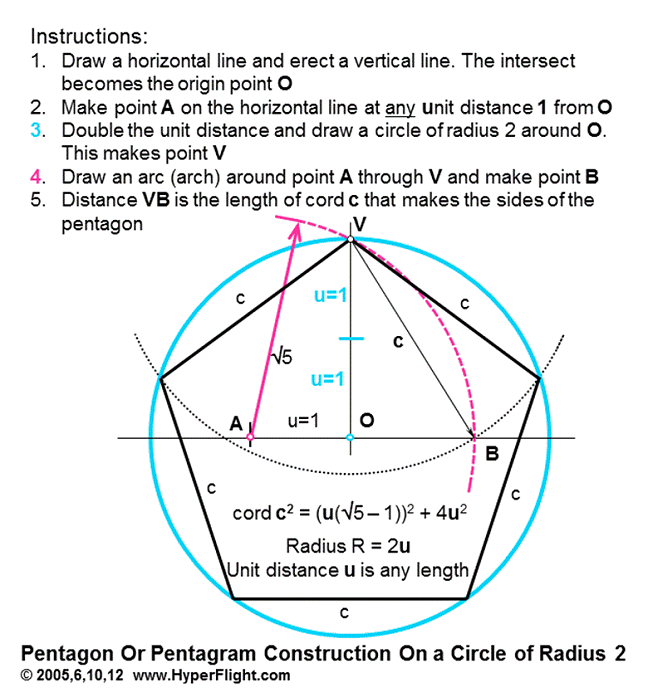 On
this page you might be tracing a pentagram in the air in two
different ways, but if you want to construct and
draw the perfect five pointed stars of the pentagon, pentacle, and
pentagram -- and learn of other stars from the perfect star family --
make a visit to the pentagon
page where you will do it with the queen of math: geometry. Also
construct the three,
four, five,
eight, ten and twelve
sided stars directly and exactly there. Some stars cannot be exact
but many are. Oh, there is more on the 16
and 24 pointed stars in our monthly topics
section because we have a single construction for both of these stars. On
this page you might be tracing a pentagram in the air in two
different ways, but if you want to construct and
draw the perfect five pointed stars of the pentagon, pentacle, and
pentagram -- and learn of other stars from the perfect star family --
make a visit to the pentagon
page where you will do it with the queen of math: geometry. Also
construct the three,
four, five,
eight, ten and twelve
sided stars directly and exactly there. Some stars cannot be exact
but many are. Oh, there is more on the 16
and 24 pointed stars in our monthly topics
section because we have a single construction for both of these stars.
From the macro of
our solar orbits to the micro of molecular orbitals. Yes, the
electrons make the standing wave valence orbitals surrounding two
atoms. Construct the new pentacle HyperStar
that has overlapping rings in the golden proportion. Valence orbitals
hold atoms together in a molecule. |
|
|
The
book
QUANTUM
PYTHAGOREANS
 More
.. More
.. |
|
Tractability is a
technical yet exceptionally important property. When
a system is tractable, it means that a mathematical solution exists
that happens in real-time.
Scientists
routinely ignore tractability and offer
"solutions" that reach the goal in, say, million years.
None such solutions match reality. Scientific
theories of evolution have two Achilles' heels:
R)
Ignorance regarding the existence of the
virtual energy. Scientists think that light
is real but light is virtual and, therefore, there exists no physical
pressure when light reflects from a mirror; and
L)
Claiming that intractable solutions are representative of nature.
The use of intractable descriptions (even intractable proofs) are not
relevant and do not happen in nature. Addressing the 'traveling
salesman' problem with intractable methods does not and will
not work because a dramatic computer
speedup does not help -- in fact, that is how intractability is
defined. Chaotic systems such as the three-body
system are intractable. Getting to another solar system by
traversing every inch of distance is intractable. [Scientists cannot
go there and remain earth-bound.]
By advocating and
by allowing intractability in the explanation
of reality, the present science cannot deliver tractable -- that is
workable, solutions. Overall, the present and taxpayer supported
science is truly a pseudoscience in its very definition of
considering but a subset of facts and also by espousing irrelevant --
that is, intractable and useless, approaches. |
|
|
|
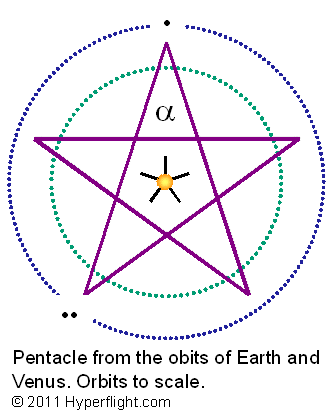
|
|
There are three aspects, or
origins, of the pentacle star. The
macro -- that is, cosmic, aspect is discussed on this page
and issues from two concentic orbits (rings). The micro aspect has
two sources: 1] The electron's orbitals in an atom, in which case the
pentacle issues from the exact division
of a single circle I call the classic pentacle; and 2]
the electron's orbitals in a molecule, in which case the pentacle
issues from two non-concentric but interlocked circles/rings I dubbed
the hyperstar pentacle.
What then is the
practical difference between the pentacle and the pentagram? The
pentacle has rings showing the origin -- either atomic (single
circle), cosmic (two concentric circles), or hyperstar
(non-concentric circles). In the end and once the mechanics of the
various orbitals (circles) are engaged the result is the pentagram.
So, technically, the pentagram is sufficient if you know where it
comes from. However, a circle
is the delimiter of context and to a practicioner it may be
important to show or draw the circles to differentiate the origin of
the resulting pentagram. |
|
|
Symbolically and fairly close to
reality, all points of the pentagram star are at midpoint between two
circles that are the orbits of Earth and Venus. The dot in the center
is the Sun. It is said Pythagoreans first used a circle around the
pentagram (making a pentacle) but now you want to use two because you
are working with two orbits. The concentric circles are paramount
because the star owns its existence to two interlocked orbits. To add
mystique, you can include alchemical symbols for the sun and the two
planets. Also add a curlicue that may look like a lower case scripted
'e' for gals (Eves) or the Greek alpha for guys (Adams). You can keep
it a pentacle but if you erase the circles you get the pentalpha or
pentagram. My preferential name for a double circled pentagram is the cosmic
pentacle -- it exists in the macro but calling it the planetary
pentacle is just as good. If you are into numbers then 5 and 8 and
their ratio 8:5 (1.6) are relevant. When the ratio is slightly
outside of 1.6, the star slowly rotates in the solar plane -- and
such is the case.
Harmony. Why, then, would
the planetary orbits be in the 8:5 ratio? Which ratios ought to be
included and which ratios excluded, and why? The answer lies in
musical harmony of planetary periods. (Harmony is also needed at the
micro in case of atomic orbitals.) A period is a reciprocal of
frequency and if we ratio the periods we are also rationing the
frequencies. Empirically we find the planetary orbit ratios
harmonious and give a great cosmic thumbs up to Pythagoras. (As to
why and what makes a ratio harmonious is in the Quantum Pythagoreans book.) |
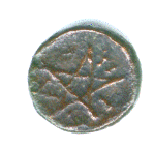 3rd-4th
century BC. Circled five point star coin or a talisman. 3rd-4th
century BC. Circled five point star coin or a talisman. |
|
Radius,
radii.
A question may come up as to the actual radii associated with rings
that represent the interlocked pentacle-producing orbits. We know the
orbital period of Venus and Earth, but what is the corresponding
orbit radius? If Johannes Kepler
were alive today he would likely have 'Dear Johan' column in the
daily paper, much the same way Kepler worked in his time when he was
the editor of an almanac making horoscopes and forecasts
(socio-political forecasts at that). As it happens, Kepler
is the author of the very equation we need for our calculation: T2=kR3. T
is the orbit period (Time)
and R
is the radius. We do not need to know k
(a constant that deals with mass) because we are interested in the
ratio of the outer ring (orbit) radius to the inner ring radius. The
ring ratio (multiplier) comes out of calculations and after selecting
the outer ring's radius we obtain the inner ring radius by
multiplying with 0.731.
If the outer ring's radius (or diameter) is 11 feet then the inner
ring's radius (diameter) is 8 feet. If you select the inner ring
first then divide
by 0.731 to get the outer ring's measure. If the inner ring is 9 feet
then the outer ring is 12' 4". No matter what the mass ratio of
the two planets may be, the pentagram will always have its points
between the rings (orbits). The math in this geometry also means that
these two rings are valid for planetary bodies of any size. |
|
For perfect
pentagram solution:
52
= kR3 (inner
faster orbit)
82
= kR3
(outer slower orbit)
(5/8)2/3
= Ratio of radii = 0.731
This result is in
effect the arithmetic solution to 'doubling of the cube' of
ancient Greeks, but it is easier to call it the '3D to 2D dimension
step up' on the Pythagorean Tetractys.
You might see this
an excellent example of the benefit of rationing.
By rationing the orbits we can draw orbits in accurate proportion
and need not be concerned about bodies' mass. Mathematically, orbit
rationing yields results that are mass-normalized. An explanation of
the benefits of proportioning is on the golden
proportion page. |
|
|
Pentacle root
properties.
A pentacle is generally associated with protection, friendship and
health. Pentacle's root is about a two-body orbit interlock
(friendship) where the protection and health aspect is the ability to
withstand chaotic environment. Similar associations lead to the acts
of bonding and marriage. Pentacle's protection and interlocking
qualities would also make a great seal. [The six pointed "Seal
of Solomon" has no protection qualities and has other associations.]
The pentacle is in the solar plane
and each point is the closest Venus-Earth approach: Pentacle
orientation cannot corrupt its symbolism. The two-dimensional aspect
of the star also makes the pentacle well suited as a shield, which is
generally any flat area or partition such as a curtain, door, cover,
sticker, seal, table, plate, coin, or a window shutter.
Perhaps the most misunderstood
aspect is that a pentacle or pentagram may appear as "just an
identification symbols." Pentacle, however, is a working tool
and produces a strong reaction. In a somewhat crude analogy, a blade
is sheathed as it is a serious tool. There are no easy or simple
explanations for the pentacle, for its workings are applicable to
both the cosmic and the atomic topologies. More you understand it, on
the scholarly or practitioner level, more respect you will have for
its properties. If you flaunt it, you likely do not understand it and
nothing will come of it. |
|
The protection
aspect of the pentacle and pentagon cannot be easily dismissed.
Atomic stability issues from waves that can close around the core
exactly. The waves, then, exist in exact integer multiples and give
atoms their stability -- and this includes the number five.
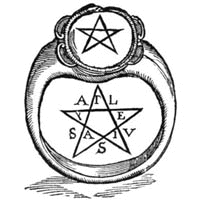 Pythagorean
pentacle has a single ring but then the
pentacle is enhanced with a second right-angle ring making it a piece
of jewelry. Pythagorean
pentacle has a single ring but then the
pentacle is enhanced with a second right-angle ring making it a piece
of jewelry.
For some stars,
such as the 7 point star, the exact division inside a circle is not
possible but could this lead to something
else? |
Presently, Kepler
is mostly remembered for the mathematical description of planetary
orbits as ellipses. Yet Kepler's equations are
also used for any and all satellites being launched into orbit -- and
'satellite' is Kepler's word, too. We have a book review, Kepler's
Witch in our archive.
|
Rotation and
revolution are closely related but it seems
only in the last hundred years or so would the five pointed star
become associated with revolutionary ideas. Without elections the
revolutionaries then work hard for no more revolutions. |
|
|
|
|
Which way is up?
There appears to be some tugging
and pulling regarding the symbolism of the pentacle or pentagram,
particularly when considering, "which way is the right way?"
or "what is the meaning of the upside down star?" From the
solar perspective this has no meaning, for the sun is in the center
of the pentacle (and pentagon as well) and there is no up or down.
The pentacle,
pentagram and the five pointed star are powerful symbols. Many groups
wish to claim them as their own. Up, down, or slightly tilted (Boston
specialty). With circles, rays, flame, letters. Yet, with the array
of attributes, the star cannot be owned by some and cannot be owned
by all. |
|
What does it mean
when the star is drawn point up or down? Upside
down? Isn't two points up better than one point up? Are both of your
ears pointing down? The complication here is that the 'up' and 'down'
designation arises strictly from the actual and physical movement.
There is no net up or down momentum in the universe as a whole
and there is no net spin. Once an object starts to move, however, the
up, down, clockwise, or counterclockwise directions begin to differentiate
on a local level. Because the momentum is conserved, a motion can
arise only in two directions simultaneously [one possibility for
one-hand-clapping koan]. Visit ConceptOne.
This does not mean that good and bad cannot be differentiated in
absolute terms. For that you will need to get into incommensurable
numbers. This topic then also includes harmony and how we (humans)
are put together: what is agreeable and what gets us unglued. |
|
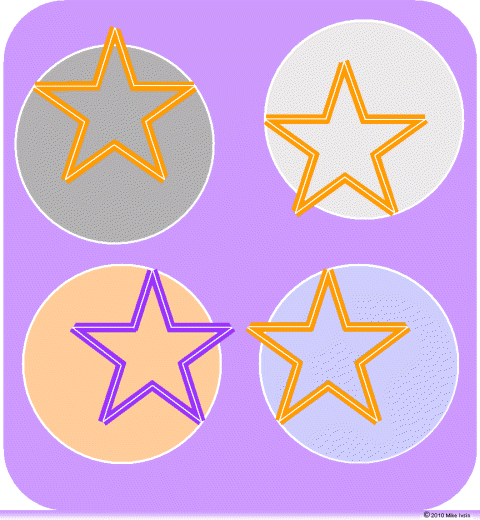 The
superposition of a man onto a pentacle or a five pointed star is not
frivolous or a fancy. Turning a person upside down
then has some negative connotations. Yet, the cosmic pentacle's
rotation does not stop and the symbolism of a 'beast' for an upside
down pentacle is tenuous here. The
superposition of a man onto a pentacle or a five pointed star is not
frivolous or a fancy. Turning a person upside down
then has some negative connotations. Yet, the cosmic pentacle's
rotation does not stop and the symbolism of a 'beast' for an upside
down pentacle is tenuous here.
A more likely
aspect is that of the 'Hanged Man' of the Tarot,
for at times a person arrives at crossroads and gets "hung
up" or chooses a new and unconventional path.
So, ease up on the
evil or beast association with the five pointed
star -- it just ain't there -- and have some fun with the stars heads
up. You can dip your toe in the water, stick your head above the
clouds, or reach out your hand and touch someone. It's about being
smart, too. Yes, there are beasts and demons but this is an advanced
topic and in time you may want to get into alchemy
to understand it. |
|
|
Pentacle's revolution.
Venus orbit period (time) around the sun is 224.70 earth days, while
the Earth's orbit is 365.24 days. The actual Earth-Venus orbit ratio
is then 1.625 -- and the actual time between pentacle's points is
593.7 earth days. The Earth-Venus interlock is not in the exact 8:5
ratio (1.60) and the pentagram issuing from the orbits rotates
in the solar plane. Actually, every point slides forward by close to
9.3 days in excess of each perfect interval of 1.6 years (365.24x1.6=584.4
days vs. 365.24x1.625=593.7days). So, after 39.27 points
(aphelions) the pentagram makes one complete revolution around the
Zodiac. Now we take 39.27 and multiply by 1.625 for 63.814
earth years for a complete revolution. Because the pentagram has
five-fold symmetry, we divide by 5 and that yields 12¾
(12.76) earth years before a point overlaps the next point. You are
the best to apply this number. "Maturity" and
"step" come to mind.
From the Earth's perspective,
when Venus is on the opposite side of Earth in the solar plane, the
merged planet is on its closest approach to the Sun. There is much
sophistication in the pentagram, much of it on the subconscious
level, and it may take some work to bring it out. |
For parametric
information about our solar system (Oss) and
each of its planets and moons, visit University
Corp. for Atmospheric Research web site. It has an excellent
internal search.
Light touch astrology
for everyday living is at this Australian web
site. They like planets as stars, for the future is in the stars, too.
|
For astrology, upon Earth-Venus
closest approach the point of the pentagram is made and
this could be projected (vectored) onto a particular constellation
or a house. Because the pentagram star's point is due to the Earth
and Venus being the closest, I would not call it the 'inferior' conjunction.
Also, making a ceremony with
properly spaced circles could and should be akin to "drawing
down Venus." Well, the Moon stands for the
Goddess -- wherever she might be -- but it's okay to always know more
(see comment on Mayans below).
In astrology there is no pairing
of planets but Earth-Venus, Earth-Mars, and Neptune-Pluto combine
with unusual properties. Pairing is important because
the concept of harmony is available only to pairs (number 2).
Moreover, a particular pair of planets makes a particular star as
planets move at their orbit frequency in the solar plane. The absence
of planetary pairing in astrology is puzzling. |
|
|
Which way is
the right way of drawing
the Pentacle? That is, how to make a pentagram in the right
order? This one is a bit easier to answer even though it may not
agree with some books. If the opening
(positive) direction is the clockwise
movement of Venus and Earth, then every third
point is traced (Venus catches up with Earth close to every 1.6
years) in the sequence shown below. |
|
|
This is the aphelion sequence for
clockwise moving planets:

|
The aphelion sequence on the left
results from two orbits, which are in the 8:5 ratio -- that is, for
every eight orbits of the inner (faster) planet the outer (slower)
planet makes five orbits.
|
To a scientist the pentacle is a
simple drawing of a five pointed star and, because
every third point is connected, the scientist will label this star as
the 5/3 star. If every second point is connected then it would be the
5/2 star. (The next point connected is at times called a stellar
number.) A scientist is not concerned with the Nature's origin of
stars -- and the geometric constructs related to their circular
creation -- and views it purely mechanistically. Heptagon, then,
would be the 7/1 star because the next (first) point is connected as
you go around making the star -- but the scientist is not concerned
that a circle cannot be divided by 7 exactly.
A scientist would not be happy
if you were to tell him that some stars are enabling (opening,
harmonious, supportive) while others are disabling (closing,
disharmonious, detractive) because a computer generated star has no
such associations. Yeah, they understand the cw and ccw direction and
have to specify it to the computer but in the end it makes no diff to
them because it produces the same result. Scientists cannot leverage
what they know about stars except by intolerance stemming from their
lack of knowledge. If you wish to engage a scientist in a
conversation, ask about different properties of chemicals having
right-handed and left-handed symmetries and why one of these has an
overwhelming presence in living things.
It is fun to watch
the religious guys, usually fundamentalist Christians, spewing forth
the evil side of numbers. After a while it
seems as if all numbers and orbits and buildings and streets and
parks have some devil in them. The universe must seem very scary to
these people: How did God create all there is and (of course)
He did not leave the building recipe in the Bible because He did not
want us messing with it. [The ancient Egyptians might have left a recipe.] |
While the 'up' and 'down' cannot
be differentiated in the solar plane, clockwise
and ccw can be, and absolutely so. |
|
The aphelion sequence for
counterclockwise moving planets is as follows:
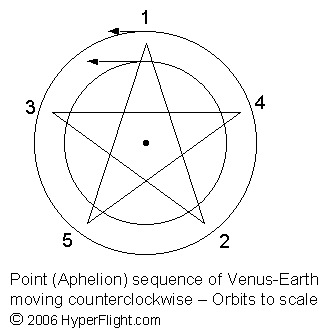
You now have
the root to compile a set of symbols associated with
penta-anything. It is very potent. The meaning of the five pointed
star of the pentagram is in the root of its creation. You now know
who is speaking from indoctrination, from knowledge, from experience,
or from a soap box. For example, if you were to create a flaming star
as a way of heating up your relationship, you could indicate the
rotation of the star when rendering the flame.
However, it is also possible that
the flaming star is some people's way of talking about a UFO, in
which case the five pointed star has nothing to do with it, flaming
or not. A flaming or a winged sphere is probably better. As for
religious applications, you are, again, the best. [My take on the
"new star in the heaven ushering new age" deals with the
human making a significant intellectual advancement such as the
Renaissance, possibly the Internet, and of course the hyperflight.] |
|
|
One way of looking
at the circle and the stars within is from the
perspective of waves -- that is, energy. Should you make a pentacle
or another star from wood or clay or metal -- that's fine but
materially there is no intrinsic differentiation between one star
with so many points and another star with a different number of
points. Yet, as soon as you understand that waves can close in
a circle only if they have certain wavelengths (read energy) and do
so only in particular wavelength integers (numbers) then many stars
unbecome eligible because they just cannot facilitate the closure in
the circle. Such numbers are not bad, they just do not have what it
takes to support the symmetry about a point. This [of course] gets to
'All is number' credo of the Pythagoreans. As a practitioner you want
to know which stars and what modality -- clockwise or ccw -- is
needed for the creation of standing waves. The 'standing wave' is a
technical but quite appropriate description of waves that form and
actually exist in the geometry of a circle.
Once you know of
other stars that are also harmonious, you will
have other choices in the creation of the circle of waves. |
|
QUANTUM
PYTHAGOREANS
 The
book of stars and pyramids The
book of stars and pyramids
Planetary
orbits and geometric stars are related to each other. You'll know
which stars are harmonious and will actualize. You will move decades
ahead once you know what works, how it works, how the stars are
constructed on a planetary scale and why. Continue.. |
|
During the geometric pentagram construction,
one encounters an abundance of the golden proportions that are
inherent in the pentagram. Because the golden
proportion is also found in many living structures -- both
plants and animals -- the pentagram also becomes associated with life
support (health) and possibly with the root of life creation. The
creation part can be somewhat complex but those familiar with
geometry of the Great Pyramid may be a step ahead. (The guts of the
Great Pyramid are 100% math, 0% symbolism. Symbolism comes from math
and your brain uses various forms of math, including shapes and
geometries, to obtain superior solutions, interpretations, and
analogies. Working the geometry of the Great Pyramid, you can
establish the arithmetic mean, the geometric mean and the harmonic
mean -- and take it from there.)
The
construction/creation of irrational numbers is done through the
Pythagorean Theorem. (Irrationals are
straight-line incommensurables.) Another class of incommensurables,
the transcendentals, resists such implementation and, of course, the
science math guys proved that the squaring of a circle is impossible.
But the scientists wish to work with 2D of a paper and do not want to
think about 3D -- even as the Great Pyramid is staring [or starring]
in their face. Scientists love to prove what cannot be done and slip
in constraints to make it so. |
|
|
|
|
|
A crop
circle showing
macro and micro? The photo on the right is that of the crop
circle discovered next to the Silbury Hill (Wiltshire) in England in
2002. I am not an avid crop circle chaser but I haven't seen a more
revealing 5-point star than the one presented here. The 13 "scales"
or "fans" or "sweeps"
(orbits, i.e., years) between points are interesting because,
according to our calculations, the Venus-Earth pentagram rotates in
the solar plane and overlaps the next point in 12¾ earth years.
There is a macro vs. micro view in the crop circle as well. In the
macro we get orbits and in the micro (inner 5-point star) we get the
two kinds of the golden triangles for the orbitals (72, 72, 36 and
36, 36, 108 degrees).
 Still,
beading around the periphery in the pentacle drawing on the left
invokes a better representation of the pentacle's rotation. 64
beads would nicely show the number of years for the star to rotate
around the Zodiac. Without the actual reference to the earth year,
the number of beads around the periphery could also be 39.27
if you want to show ("point out") the rotating aphelions as
they happen. Still,
beading around the periphery in the pentacle drawing on the left
invokes a better representation of the pentacle's rotation. 64
beads would nicely show the number of years for the star to rotate
around the Zodiac. Without the actual reference to the earth year,
the number of beads around the periphery could also be 39.27
if you want to show ("point out") the rotating aphelions as
they happen.
|
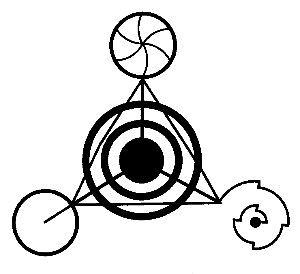 More
recent crop circles are geometric for the geometry sake and do not
reveal much. They even "abandoned" the circle-square
emphasis. I think the circle makers (okay, ETs), are smarting up from
our quick adaptation of their geometry to our own needs. There is a
nice example of this from the Barbury Castle 1991
Tetrahedron. Although the 1991 Tetrahedron is exceptionally
powerful in the revelation of the fundamentals, the Barbury Castle
2008 Pi crop circle is somewhere between worthless and misleading --
as far as atomic construction or gravitation is concerned -- even if
it is a pretty though asymmetrical design: The decimal fraction is
useless in circular geometry because the transcendental numbers can
be worked tractably only geometrically. More
recent crop circles are geometric for the geometry sake and do not
reveal much. They even "abandoned" the circle-square
emphasis. I think the circle makers (okay, ETs), are smarting up from
our quick adaptation of their geometry to our own needs. There is a
nice example of this from the Barbury Castle 1991
Tetrahedron. Although the 1991 Tetrahedron is exceptionally
powerful in the revelation of the fundamentals, the Barbury Castle
2008 Pi crop circle is somewhere between worthless and misleading --
as far as atomic construction or gravitation is concerned -- even if
it is a pretty though asymmetrical design: The decimal fraction is
useless in circular geometry because the transcendental numbers can
be worked tractably only geometrically. |
|
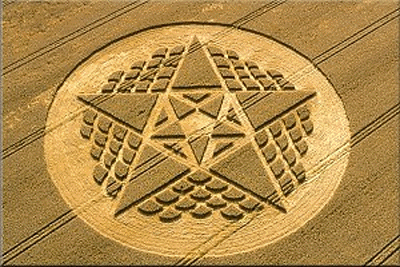
|
Scales are not
exclusive to fish because dragons have scales as well. We
are not explaining the meaning of mythology here but the idea is
that the scales and sweeps are related through the Pi that is a
circle (alchemical dragon) and/or a sphere (Chinese dragon) and --
viola -- we are back to geometry.
The dragon of the
Mayans is slightly different. The mountain is
still there but it has the oval (or clam shell or saucer) shape of
their number zero.
Then there is the
Trout Engine of Schauberger .. .. and the
geometry of the scales themselves. Yes, this is about the ZPE. |
|
|
|
|
Here
is the illustration of the actual
pentacle trace
in the making -- the trace of the merged Earth-Venus planet in the
8:5 orbit ratio. The straight (shorthand, simplified) 1-2-3-4-5-1
sequence appears to be counterclockwise but the actual curved trace
is always clockwise. Yep, there are five
curlicues there in all and the illustration below shows the first
one. In the second illustration the curlicue is the second one that
happens 12¾ years later.
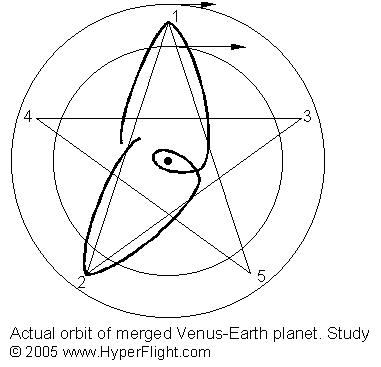
Pretty advanced
shape. Am I the only one who sees a part of a human body in this shape?

Draw
the star in the air, for that is how the Sun feels the dynamics of
Venus and Earth. Chart the star in your heart and make a friend. |
|
 A
collection of designs inspired by the five pointed star. Select
designs have a page of their own, but visit our
store at Zazzle (.com/Mike_Geo) too.
How would you look in a tee, a hoodie, or a long sleeve shirt,
even under a jacket?
You could be bold, subtle, intriguing, fancy, plain witchy, never
cute. In any case, all our designs come from nature and center on the
golden proportion. A
collection of designs inspired by the five pointed star. Select
designs have a page of their own, but visit our
store at Zazzle (.com/Mike_Geo) too.
How would you look in a tee, a hoodie, or a long sleeve shirt,
even under a jacket?
You could be bold, subtle, intriguing, fancy, plain witchy, never
cute. In any case, all our designs come from nature and center on the
golden proportion.
 The
first design is called The Spirit Rising while the next one is The
Night Jump. The
first design is called The Spirit Rising while the next one is The
Night Jump. |
|
|
 |
|
Two-Pointed Star
pattern is made by Neptune and Pluto
If
you take Pluto away, you cannot play musical orbits.
The
3:2 ratio is a well known musical ratio -- but not well known to scientists.
If
a two pointed star is the north-south star, what happened to the
east and the west? |
|
|
Orbit period is
the reciprocal of frequency. Music is about
frequency. Scientists are the living proof some people use less than
10% of their brain.
Physically nothing
would change if Pluto were to be declassified as a planet
but if it keeps scientists in the news to their own detriment so much
the better. The real issue is their incompetence when it comes to
global warming. This sticks out when we look at the scientist's
ignorance in the area of light-gas
interactions. |
|
|
Neptune-Pluto orbits are also
interlocked but in the 3:2 ratio -- for every turn of the outside
(slower) planet that is Pluto, the inside planet makes 1½ turns.
The Neptune-Pluto duo can then be merged into a single planet with
the resulting approximate orbit shown below. The combined planet
makes a curlicue around the central sun before making the second
point of a two-pointed star. The combined planets' orbit completes
and, therefore repeats, every two Pluto orbits. This orbit,
tentatively named Catseye ("the eye of the pussy") also
denotes stability similar to that of the pentacle. It can, of course,
be applied if the outer planets are to be preferentially referenced. |
|
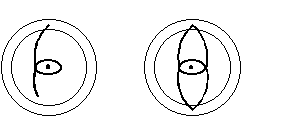 |
|
The making of the two-pointed
star is along the same mechanism as that of any multi-pointed
star. Kepler's equation is again appropriate for obtaining the
ratio of Catseye-creating radii.
You may want to experiment
combining three orbits into a triple ring -- but consider that one
orbit (one planet such as the Earth) would become the reference for
the other two.
All
merged orbits are continuous in mathematical terms -- that is, the
points may be tight and sharp looking but all points are rounded.
Having its ends curved may seem a bit of trivia -- yet some
difference exists when comparing the actual combined (merged)
trajectory that has rounded points and the compass drawing of two
intersecting circles with discontinuous transitions claiming to have
"divine" geometry. In actuality, all planet made stars have
rounded points and the geometric construction is a stylized
representation of the actual (see below). Geometric ways and means,
however, is the computing platform of
the cosmos.
You may enjoy the fact that the
two-pointed star is a bit of an enigma because the general up-down
direction may seem "not really a star." The three-pointed
star could be claimed to be the "lowest point star." Not
so. With the extra curlicue and some width, there certainly is the
two pointed star because the star exists in 2D. |
|
For perfect
Catseye solution
22
= kR3
(inner faster orbit)
32
= kR3
(outer slower orbit)
(2/3)2/3
= Ratio of radii = 0.763 |
|
|
|
 |
|
The eight-pointed
star is made with the Red Planet |
|
The
octagon and thus the number eight is sourced from the Earth-Mars
orbit relation. However, there are several ways of making the eight
pointed star and that introduces the geometry of the diagonal. The
number eight also continues its presence from the Earth-Venus orbit
ratio (8 Venus' orbits for every 5 of Earth). We are, then, dealing
with several topics when working with the eight-point star. |
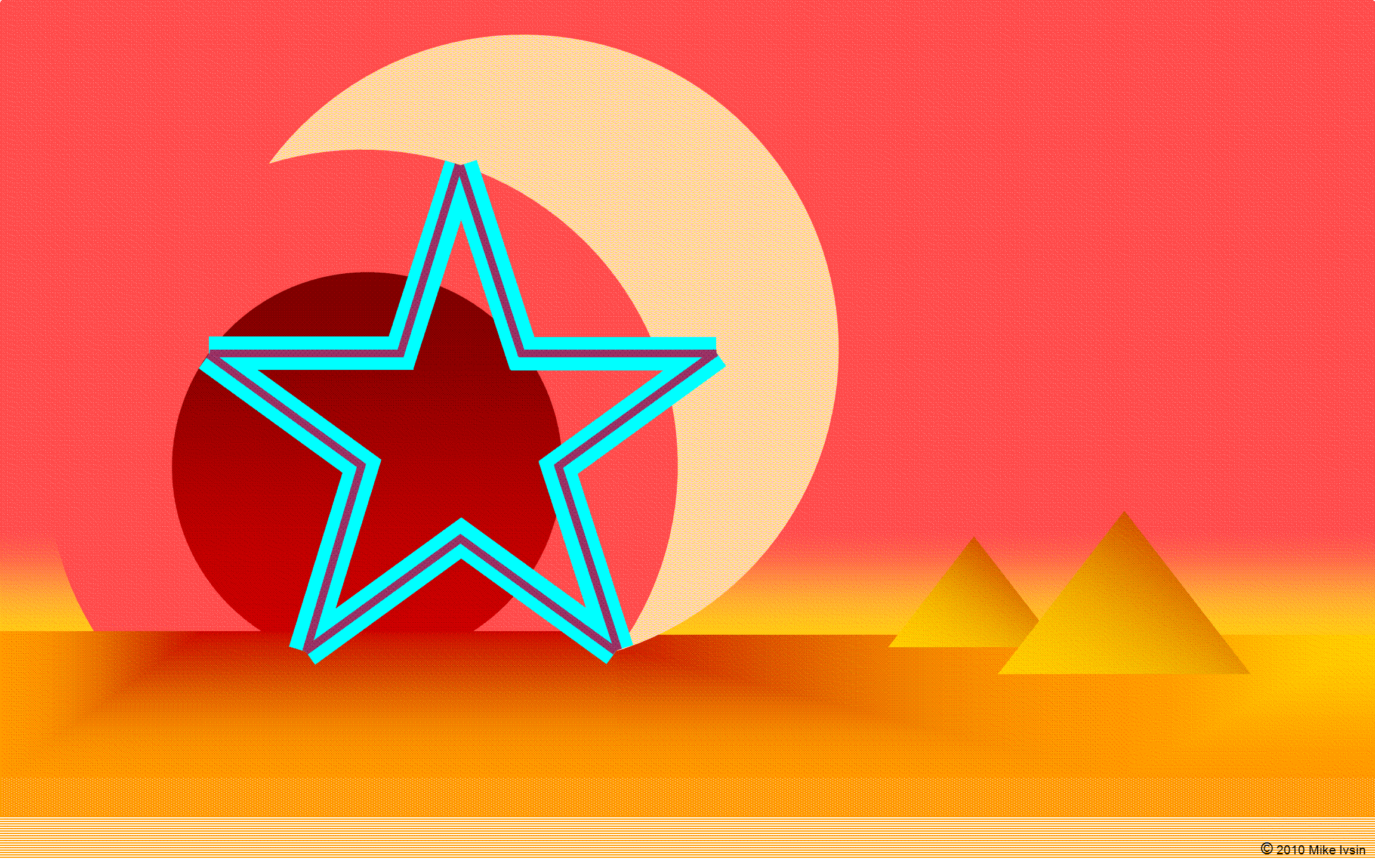 This
Mars Again design is from our nature inspired series. Also
available in limited edition as a print in Euro A1 size. This
Mars Again design is from our nature inspired series. Also
available in limited edition as a print in Euro A1 size. |
|
Octagon star
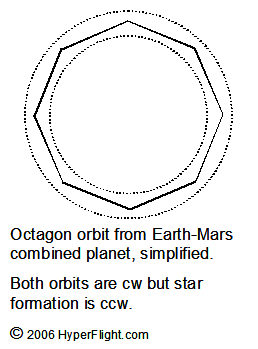 Earth
has an orbit interlock with Mars as well. This orbit ratio is 15:8
and it is the ratio of two notes of the musical octave. You will need
to find two notes of the octave that, once put in a ratio, will yield
the musical frequency ratio of 15:8. It is a ratio of two notes and
that means they need to be played together. Why do these two numbers
make a harmonious and pleasant sounding ratio? There are some
mysteries left to be pursued and this is answered in the book. The
fact that you and your friend agree that this ratio sounds harmonious
is perhaps another mystery -- but there is no reason the human brain
would not inherently differentiate harmonious (pleasant) and
disharmonious (unpleasant) sounds [we are, really, put together
rather well]. Earth
has an orbit interlock with Mars as well. This orbit ratio is 15:8
and it is the ratio of two notes of the musical octave. You will need
to find two notes of the octave that, once put in a ratio, will yield
the musical frequency ratio of 15:8. It is a ratio of two notes and
that means they need to be played together. Why do these two numbers
make a harmonious and pleasant sounding ratio? There are some
mysteries left to be pursued and this is answered in the book. The
fact that you and your friend agree that this ratio sounds harmonious
is perhaps another mystery -- but there is no reason the human brain
would not inherently differentiate harmonious (pleasant) and
disharmonious (unpleasant) sounds [we are, really, put together
rather well].
The harmonious and disharmonious
nature is absolute because we are able
to agree on which is which. So far, the ratio of two notes that
results in 15:8 (and that is musically harmonious)
is in agreement with the ratio of the Earth-Mars orbits.
Just as we did in the
Earth-and-Venus case, the Earth-and-Mars merged planet has aphelions
from time to time and this happens when both planes are closest to
each other. Connecting the aphelions results in the octagon. Because
of the orbit ratio, the points of the octagon happen in the ccw
fashion while both the Earth and Mars are taken as moving clockwise.
The eight pointed star of the octagon then also represents a
harmonious relation even though points happen counter-clockwise. The
trace of the Earth-and-Mars merged planet happens clockwise but the
aphelion points happen (peak out) in the counterclockwise sequence
without skipping points.
An eight pointed star that skips
points, however, may or may not be harmonious. [This is more than a
homework for the Muslims, for they do not seem to understand this.]
There
are several eight
pointed stars. The octagon is traced in a
sequence and different orbit ratios account for its clockwise or counter-clockwise
path. Skipping every two points draws every third point and results
in an eight point star that could be called the octagram or octacle.
Skipping every four points results in the identical octacle except
that the order of drawing the points is different.
No
even-pointed star can be drawn by skipping a single point because
only half of the points would be traced. Arithmetically, this deals
with division such as when the attempt at drawing the 6:4 ratio
actually produces the same star as the 3:2 ratio does. This could be
a nice instance of applying the operation of division in nature.
If
you want to get into multi-pointed stars in more depth, the gateway
question is: "How come 15:8 is harmonious (or musical) but 9:8
is not?" This will open up to other areas such as the absence of
the six and seven pointed stars in orbit topologies. The
true and harmonious eight pointed star comes from the 15:8
Mars-Earth orbit ratio that is in the shape of the octagon.
The
eight pointed star is usually associated with Sun or Venus but you
will need a better rationale besides just 'someone says' or 'someone
wrote.' From the ancient carvings, the semicardinal directions are
strongly differentiated from the cardinal directions. The eight-fold
symmetry does not have an equal weight or meaning when it comes to
the diagonal.
The point is that
the "eight-pointed" star is not necessarily about eight
points. The cardinal and semicardinal separation takes precedence to
"counting to eight," because the symbolism of the diagonal
deals with the important aspect of transformation that is based
on the geometry of the diagonal. It is
likely that the "wavy" nature in the depiction of some of
the diagonals is what leads some to think of "sun rays" and
hence the Sun. Not so. We have depictions of other Venus stars --
their diagonals have different graphics and do not support the
symbolism of the Sun.
Logically, the Sun
is at the center and without an orbit the Sun cannot create a
geometric star shape.
|
In the Mayan
mythology Venus is called "the great fake" in
connection with early Mayans confusing Venus with sun. Confusing
Venus with the Sun is by itself confusing but the story goes on in
that a great spirit or god "lifted the clouds" and allowed
sun to be seen in addition to Venus (or allowed Mayans to
differentiate Venus and sun). Esoterically, then, you may want to
think of Venus as having intelligence that is much broader -- or as
having a greater dynamic -- than that of the Sun. This is also
supported by the story of one of the Mayan Twins who, as a trickster,
becomes Venus. If you are a scientist you might think of intelligence
as nonlocal and organized energy. This is also confusing but it's the
best bridge [and last hope] for you.
If you think
all this is just a bunch of gobbledygook,
that's fine. What helps here is that in the West we are under the
influence of the Pythagorean and the ancient Egyptian traditions but
in Mesoamerica the tradition is in the interstellar travel. Think the
'Operations of the Sun' (Tetractys) vs. the 'Operations of the Stars'
(Hunab Ku). [There also exist the 'Operations of the Moon' and I have
a brief description of these operations on the Alchemy page.] |
|
Diagonal is
about transformation
Searching for the
meaning of the eight pointed star is also a search for the meaning of
the diagonal. People can make nifty eight
pointed stars with pronounced semicardinal directions (Rome's St.
Peter's Square an excellent example) but that does not capture the
idea of the diagonal. Similarly, the second rotated square making a
diagonal of the "Muslim star" does not appreciate the
qualitatively different role of the diagonal. A better understanding
of the diagonal is in the Greek/Russian Orthodoxy where the diagonal
is directly associated with the transformation of the soul, although
-- like most religions -- they want you to "transform" to
their side.
Surprisingly, a
scientist may have easier time with this because
the diagonal of the Hermit (square) matrix has properties that hint
strongly at the transformative aspect of the diagonal [think
conjugation -- and I mean this in the math context]. In the book Quantum
Pythagoreans, another transformative
aspect is invoked at the diagonal of the hyperbole, which is treated
in the context of transitioning (and the necessary transforming) of
data between the left and the right brain.
In the East, the
transformative aspect is in the virtual ("empty" or
'negative space') S shape that is in the middle of the Tao
symbol.  Preferentially
it is composed of two gap-separated paisley shapes instead of a
diagonal, which conveys the idea of 'not horizontal and not
vertical.' The gap exists, for there must be a separation (and
joining) between the real and the virtual domains. (Technically, a
wave couples across the gap.) Whatever gets from one domain to
another is subject to transformation. As a Tai Chi practitioner you
might be ready to answer the question: "Why should I keep my
foot at a diagonal?" Preferentially
it is composed of two gap-separated paisley shapes instead of a
diagonal, which conveys the idea of 'not horizontal and not
vertical.' The gap exists, for there must be a separation (and
joining) between the real and the virtual domains. (Technically, a
wave couples across the gap.) Whatever gets from one domain to
another is subject to transformation. As a Tai Chi practitioner you
might be ready to answer the question: "Why should I keep my
foot at a diagonal?"
At times the Tao
symbol is shown with dots of the opposing color in the middle of
paisley fields. This is an interesting addition
even Buddhists fail to interpret in their literature. (Martial arts
literature tends to discard the dots altogether.) It deals with
alternate means of bridging the gap and you will need to get familiar
with this site to understand it.

|
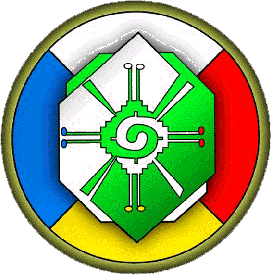
In the
Mesoamerican tradition the diagonal is approached via the Hunab-Ku (or
Hanub Ku), which combines a straight diagonal with rotation while
resembling the bar/spiral galaxy. The double-line axes drawing method
is really about the empty (that is virtual) axis of symmetry [very
impressive]. Note the absence of the number three. This is highly
indicative of the virtual domain and so the Hunab Ku needs to be
approached via the right brain methods because the rational,
argumentative analysis just does not work (yes, this is about the
separation of the duality [and about wasting your time with
scientists]). The number seven seems to be transformative as well and
this is likely because 7 is the lowest number that cannot divide a
circle exactly.
Hunab-Ku is
possibly the most complex symbol of all. Unlike
Tetractys or Tao or Ankh or even AUM, it is likely not meant to be
evolved but 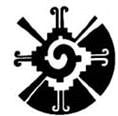 carefully
decomposed. For example, one of the indigenous names for Hunab Ku is
(the) Galactic Butterfly. You may go off on tangents here with all
kinds of symbology (thinking of the dual line as a butterfly
antenae), but, as a Pythagorean you'll stick to geometry and figure
out that the two heptagons are free to pivot about a common axis in a
butterfly resembling action. Hunab Ku has the real-virtual duality on
the atomic level and their transitions via the diagonals. It has
subtle even-odd symmetry interplay and conveys 3D modulation aspects.
If you get serious on this subject you want to be as authentic as
possible. Almost all Hunab Ku pictures on the Internet are colorless
and the heptagons taken out -- and that just about destroys your
ability to understand it. When traveling in the virtual domain (of
the hyperspace), you kinda jump from here to there in the zig-zag
fashion -- and so I'd also see it as being the Galactic Butterfly. carefully
decomposed. For example, one of the indigenous names for Hunab Ku is
(the) Galactic Butterfly. You may go off on tangents here with all
kinds of symbology (thinking of the dual line as a butterfly
antenae), but, as a Pythagorean you'll stick to geometry and figure
out that the two heptagons are free to pivot about a common axis in a
butterfly resembling action. Hunab Ku has the real-virtual duality on
the atomic level and their transitions via the diagonals. It has
subtle even-odd symmetry interplay and conveys 3D modulation aspects.
If you get serious on this subject you want to be as authentic as
possible. Almost all Hunab Ku pictures on the Internet are colorless
and the heptagons taken out -- and that just about destroys your
ability to understand it. When traveling in the virtual domain (of
the hyperspace), you kinda jump from here to there in the zig-zag
fashion -- and so I'd also see it as being the Galactic Butterfly.
Here is the actual
text from the THE BOOK OF CHILAM BALAM OF CHUMAYEL, by Ralph L. Roys,
Chapter X, Creation of The World:
"The
plate of another katun was set up and fixed in its place by the
messengers of their lord. The red Piltec was set at the east of the
world to conduct people to his lord. The white Piltec was set at the
north of the world to conduct people to his lord. Lahun Chaan was set
<at the west> to bring things to his lord. The yellow Piltec
was set <at the south> to bring things to his lord. But it was
<over> the whole world that Ah Uuc Cheknal was set up. He came
from the seventh stratum of the earth, when he came to fecundate Itzam-kab-ain,
when he came with the vitality of the angle between earth <and>
heaven. They moved among the four lights, among the four layers of
the stars. The world was not lighted; there was neither day nor night
nor moon. Then they perceived that the world was being created. Then
creation dawned upon the world. During the creation thirteen infinite
series <added> to seven was the count of the creation of the
world. Then a new world dawned for them."
However,
although the Chapter X describes the Creation of The World, one
should also look at it as making a transition from the virtual to the
real domain. During the transition, the real world begins to appear
and indeed when coming in from hyperspace one witnesses the
"creation" of the world. The number 13 and 7 are
significant because (along with 9 and 11, which are not mentioned)
they take you from the virtual domain. It is a form of banishing, or
as I would say disharmonious, event that takes you to the material
world (of the "macro eigenstate"). But of course,
Mesoamerica is about interstellar travel and if you get good at this
you might even get recruited(?)
The word Hunab Ku
was coined after the Spanish conquest and much musing centers on
"how could a supreme and sole god have had no name?" This
is something for the left-brainers to worry about. Lao-tzu talks
about Tao being nameless and when you assign a name to something the
likes of the infinite Tao having infinite dynamics, it is no longer a
name for true Tao and so when we call it Tao it is just a working
name rather than a real name. In other words, Tao is virtual and not
real. And so is Hunab Ku, except that the way the symbol is set up
deals with the creation of things and forces. Very nice. But of
course, I totally enjoy the rational groping of the scientists.
Once you get to a
certain point, you will see the real aspects
and appreciate another name for Hunab Ku: The One Mover and Measurer.
This is identical to the 'movement and placement' pursuit of ancient
Greeks, although they did not seem to get to 'The One' source of it. (Philolaus,
a 4th C. BCE Pythagorean, starts off nicely with 'the Hearth, the
first thing fitted together, being The One in the center of the
sphere' -- but it seems neither Aristotle or Plato could advance it.)
And yes, the measurement/placement part is about the real numbers.
Continuing on you will have fun with yet another name for Hunab Ku:
Spider Water. Think cardinal and semi-cardinal directions for the
spider (not an insect) and be smart if unconventional about (the)
water. Self-test:-) If you already connected 'movement' with force,
you are doing well. Oh, think of water in the "fire into
water" context of ancient Egyptians but this time it is more
about travel rather than creation.
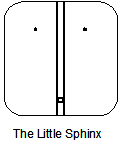 Many
Mayan concepts such as the tribes (I call 'faces,'
others 'kin') were redrawn to look cute. This could be seen
as continuation of reduction, if not erasure, of the Mayan culture.
I'd call this face 'The Little Sphinx:' Love to hear your
interpretation(s). Power of this face is in the logic of its details.
For example, there is a reason the "eyes" are not little
rings like the "mouth." The double vertical line is very
revealing as well but is reduced into a single line in some renditions. Many
Mayan concepts such as the tribes (I call 'faces,'
others 'kin') were redrawn to look cute. This could be seen
as continuation of reduction, if not erasure, of the Mayan culture.
I'd call this face 'The Little Sphinx:' Love to hear your
interpretation(s). Power of this face is in the logic of its details.
For example, there is a reason the "eyes" are not little
rings like the "mouth." The double vertical line is very
revealing as well but is reduced into a single line in some renditions.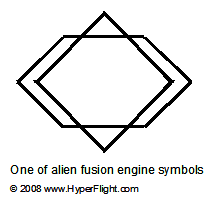
One input
is from David Adair's recollection of symbols he saw on the alien
engine. (I call it the energy-charge overlay, even though David calls
[not persuasively] all the symbols he found on the engine just
"serial numbers for parts.") It's a good start-up symbol
and now the rest of it comes from both the real and the virtual
domains while differentiating irrationals and transcendentals. Oh,
there is a big difference between numbers and numerals. (Ten is a
number, Tetractys a numeral ten.)
The story has
it that govt codebreakers came up empty handed when given the symbols
from the alien engine. These symbols are truly the universal symbols
of the physics of the universe [and if your head is filled with
Albert it will crack before the code does. But of course it is not a
"fault" of but one person. The reductionists make a great
effort to reduce and corrupt our understanding of nature.]
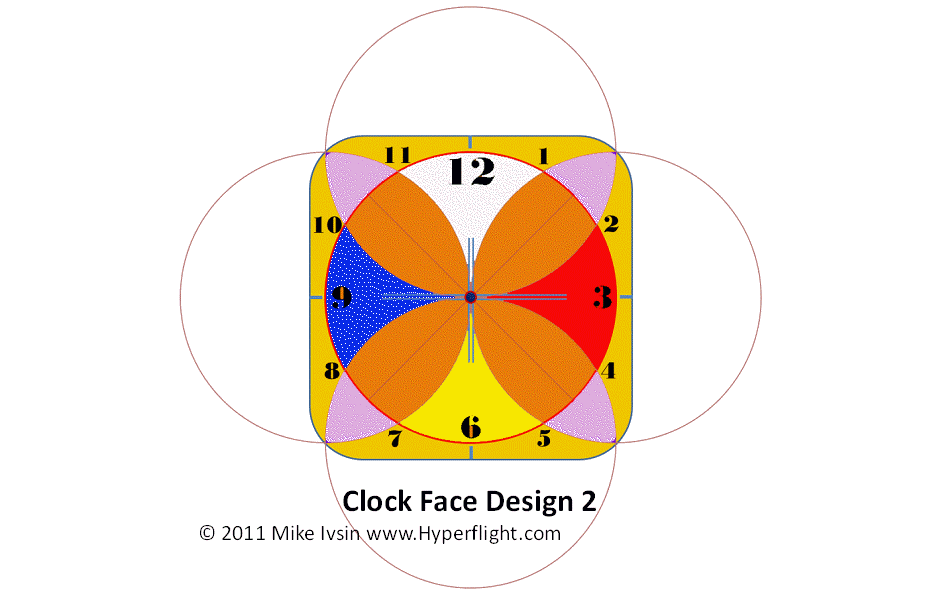
Here is a more earthly
inspiration from Hunab Ku: A watch face design showing the
eight fold and the twelve fold division of a circle.
The construction is easy to figure out from the five circles but we
have more
detail on the combined 12-and-8 pointed
star construction. |
|
|
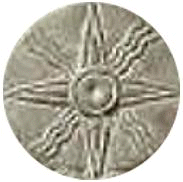 This
symbol, while associated with Venus, is about the diagonal that is
transformation. The idea, then, is to look to Venus for her
transformative qualities. In general, a transformation deals with the
exchange of real and virtual energies. As such, transformations can
be personal or can deal with free energy extraction, Martial arts,
space travel, or new computational modalities. This
symbol, while associated with Venus, is about the diagonal that is
transformation. The idea, then, is to look to Venus for her
transformative qualities. In general, a transformation deals with the
exchange of real and virtual energies. As such, transformations can
be personal or can deal with free energy extraction, Martial arts,
space travel, or new computational modalities.
[I've seen this
star associated with Shamash, the sun-god. Not so. Sin, the moon-god
was the chief who procreated Shamash the sun-god as well as Ishtar,
the goddess-Venus and the star is definitely hers.]
  The
Mesoamerican Venus symbols appear to be based on the number eight
but the symbols make quite a distinction between the cardinal and
semi-cardinal directions. The
Mesoamerican Venus symbols appear to be based on the number eight
but the symbols make quite a distinction between the cardinal and
semi-cardinal directions.
|
Sun vs Venus,
What's going on?
For a while Mayans confused Venus
with Sun and there are several references to it just four paragraphs
above. Two paragraphs above the eight pointed Venus star is
attributed to Sun god. What's going on?
Let's just continue. The eight
pointed star on St. Peter's square in Rome is ascribed to Venus and Sun
by several web sources. At least one Islamic art web site claims the
encircled eight pointed star is a Sun symbol. There is a tendency to
use the phrase 'Sun Wheel' when talking about a circled eight pointed
star. Finally, ancient Greeks thought the Morning and Evening stars
were different stars. Is Venus really a "Great Fake?"
The British Museum has a nice
piece and the description of it. Perhaps that should clear it up:
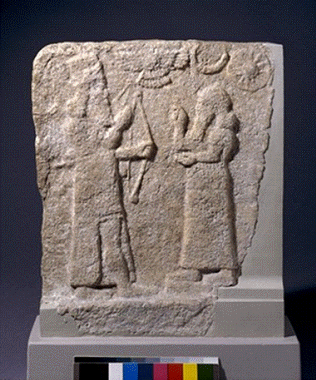
The British Museum Description:
"Gypsum tile from a domestic
shrine; a man in Assyrian court dress is worshipping a god, perhaps
Ninurta; the symbols above the man's head represent, from left to
right, Shamash the sun god, Sin the moon god, and Ishtar the goddess
of the planet Venus." |
|
|
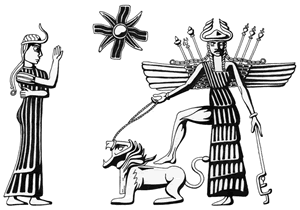
Venus in the
Mesopotamian tradition --
the land of Sumer. The "eight pointed"
star of Venus strongly differentiates cardinal and semi-cardinal
directions while hinting at pulsing, vibration, and counter-rotation.
[Venus on the right does not look happy camper and could have high
emotional content -- commenting on her pretty leg might not be
returned in kind. A woman on the left appears Egyptian and could be
saying, "A woman has to do what a woman has to do."] |
In the ancient
Egyptian context, the god of wisdom and magic Thoth is depicted full
of diagonals. We have a picture of him on a
page dealing with the squaring
of a circle.
|
As Australians
look for a star that would enhance their identity,
this site contributed a particular
star that does not forget the diagonal. |
|
|
 |
|
|
|
|
|
Occult,
by definition, means hidden. You do not want
to play with someone hiding cards up his or her sleeve, yet we all
like to keep our privacy. In our case, it is the relationship between
two patterns that is not obvious: How the flat
(2D), five pointed star relates to two rings and
vice versa.
You may appreciate
the occult if you think the subconsciousness dominates (Carl Jung
& Co.). A particular eight pointed star is
created arithmetically from two orbits/rings but because the orbit
periods could be mutually disharmonious, the star will not happen for
real orbits -- will not actualize. Now the idea is that if you know
which stars are harmonious and which are not, you may think you would
be able to affect the outcome of a relationship using such stars.
Similarly, a star that is culturally embedded may give the wearer
certain characteristics even the wearer does not recognize.
Alchemy appears strange to the
point of occultation or encoding. It is easy to make a
point that Alchemy is trying to hide something, particularly since
some alchemical texts speak of keeping the knowledge from the
profane. Not really. Alchemy uses its own set of tools that need some
work before these can be applied. I offer the Pythagorean
interpretation of The Emerald Tablet on the Alchemy page.
We also have a
book review On
Becoming an Alchemist by Catherine MacCoun |
|
|
|
Occult? Well,
you cannot see the multi-pointed orbits but you can compute them. The
shape of the shared orbits can never be observed but can be
visualized or heard. The Sun indeed feels the shared obits
gravitationally because the planets are computationally combined. The
metaphysical question here is really the reverse: If you draw
a pentagram, are you in fact computationally and subconsciously
creating the two specific interlocked orbits?
If you think geometry rules (and
it does), wearing a steel helmet just might not work. Thinking that
geometry and numbers are illusions just might not work.
One way of drawing
a pentacle is harmonious -- think 8:5, which is also called
'invoking.' Another way of drawing a pentacle is disharmonious
(closing) -- think 7:5, which is also called 'banishing.' The ratios
of 8:5 and 7:5 come from modulo math. Every time you draw the
pentagram ccw you are creating the standing waves and every time you
draw the pentagram cw you are dissolving the standing waves. (Some
sources such as the Golden Dawn got it mixed up.)
One way of drawing
a pentagon is harmonious -- think 6:5;
Another way of
drawing a pentagon is disharmonious -- think 9:5.
Note that the
pentagram and the pentagon have different modulo mechanics. The
modulo math as it is known today takes one reference as fixed. In
nature, however, everything is orbiting and in our case both the
Earth and Venus are relating dynamically to each other. This
generalization, or unfixing,
of modulo math is described in one of our DSSP topics. |
|
 |
|
|
One mathematical
component in merged planets and subsequent star formation is modulo
math but it harkens
back to Pythagoras as well because we deal with the basic Pythagoras'
and Greek work on rationing -- albeit in the orbital geometry. Modulo
math is funny in a sense that applications are not readily apparent.
(Perhaps the best known application is the summing of digits of large
numbers to test for divisibility.) It is said Gauss
enjoyed modulo math and came up with a number of mathematical
relationships in this area. Only recently, the biggest and very
practical modulo math application surfaced as public key cryptography. |
|
|
NASA,
as usual, cannot
get there.
When all planets are computationally combined, there exists one
overall wobble onto our Sun. Unfortunately, the wobble (periodic
deviation) of other solar system's suns
cannot be correlated to the number, size and orbits of planets other
solar system may have. That is, knowing the overall wobble, the
wobble cannot be decomposed into specific planets and orbits, even if
we know that the orbits are interlocked in musical orbit ratios. In
fact, this is the primary mechanism behind the public key
cryptography. Don't bother telling NASA, however, for they are busy
telling us about the size and distance of a single "planet
discovery" based on the overall wobble. If NASA can see a
wobble of another solar system that is grossly out of kilter, they
then also spend some more money misinterpreting it. |
|
 |
|
Summary |
Q:
We understand vibration and tones for making music.
But you say that the gravitational force working the planetary
(macro) bodies needs to subscribe to music as well. Is not the force
of gravitation just a mindless force -- this times this divided by that?
A: For
some, perhaps. For others, gravitation also
organizes things into tractable topologies, particularly since this
allows more than two bodies in the universe.
|
 Venus
symbol in the Mesoamerican tradition appears
to be based on the number 8, possibly as Venus
symbol in the Mesoamerican tradition appears
to be based on the number 8, possibly as
1) The
eight Venus cycles that synchronize with Earth's five years, or
2) The
eight Earth's years that synchronize with Venus' thirteen cycles, or
3) The
relative importance of cardinal and semi-cardinal directions as
issuing from planetary orbit observations and counting. Diagonal --
that is semicardinal -- direction is about transformation (evening
& morning?) [my vote here].
There is
likely a hyperbolic trim on the star, too.
Numbers 0, 1,
5, 13, and 20 are prominent in Mayan numerical and calendar systems.
For better or for worse, Mayans (used zero but) did not use fractions
[running out of pegs on a calendar wheel because of that? Or is it
because they did not get to irrationals and transcendentals via
planet orbit integers?] |
|
|
Music
is vibrations. Orbits are periods that define vibrations. The
Catseye orbit results from Neptune-Pluto interlocked ratio of 3:2 or
1.5. Interlocked orbits can make a number of star configurations but
the planetary interlock usually does not exceed the ratio of 2.0. (Quantum
Pythagoreans book has the ratios for planets and moons and the
corresponding stars.) Because the musical octave spans orbital ratios
from 1.0 to 2.0 then the Catseye ratio of 1.5 corresponds to the Sol
note, which is a "fifth" played by C and G. (Music guys
make it more complicated than it needs to be -- and so we will stay
with ratios.) Both notes need to be played to obtain the 3:2 (1.5)
ratio and can be played at any particular octave. These tones then
reinforce the symbolism of the Catseye. You can now construct the
associative symbols of the Catseye that will acquire a symbolic
meaning: numbers 3 and 2, their ratios,
and notes of the (Western) octave C and
G, and the eye shape itself. The eye shape can be rotated 90 degrees
to resemble the cat's eye. [The shape then also begins to look like a
winged sphere but I would not go that far.]
The topic of Pythagorean
celestial tones can get mystical, particularly if you get into chords
and harmonics, which then reinforce and possibly create other orbits
-- some claiming to be able to hear the music. The correspondence of
the pentagram's 1.6 ratio to a particular tone makes for a good
exercise. Another ratio is 5:3 and this corresponds to notes C and A
(ratio 12/3 or 1.66). If such orbital
ratio were to exist (corresponding to musical ratio of notes C and A)
then the merged planet would make a three-pointed star orbit.
Three-pointed merged planet orbit does not exist in Oss [yet? or
perhaps it exists at another solar system]. |
|
Additional
things to consider arise when considering the 13:8 ratio. This ratio
is not on the musical scale but, arithmetically, it is closer to the
actual measurement of the Venus-Earth orbit ratio, which means that
the rotation of this star is slower than that of the pentagram. Both
8:5 and 13:8 are ratios of two consecutive terms of the Fibonacci
sequence of numbers. It makes for a good exercise to figure out the
star that issues from the 13:8 ratio and what advantage, if any, this
star brings to the table.
Fibonacci sequence
grew from but a series of numbers
into the golden ratio a:b
when Kepler discovered that the ratio of two consecutive Fibonacci
numbers converge toward (1+SQRT(5))/2. Normalized,
the golden ratio is 1.6180.. to 1. Because the actual Venus-Earth
orbit ratio is very close to the golden ratio (1.625 and 1.618,
respectively), any
ratio of two consecutive terms of the Fibonacci sequence will make a
ratio that is a very close fit with
the golden ratio of 1.6180. Some examples:
8/5 (1.6), 13/8 (1.625), 21/13 (1.615), 34/21 (1.619), 55/34 (1.618),
etc. If somebody proclaims that the eight or the thirteen or the
twenty-one pointed star represents Venus -- you will know where he or
she is coming from. |
|
 |
QUANTUM
PYTHAGOREANS
Book by Mike Ivsin
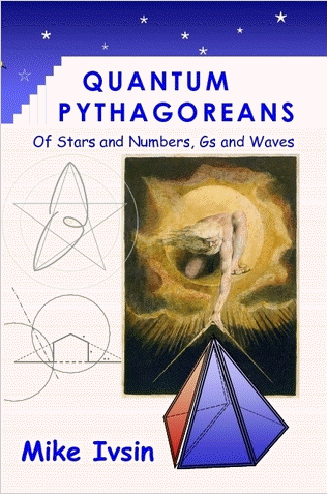 Musical
tones have equivalent representation in geometric stars. Planetary
orbits also have representation in geometric stars. There are, then,
harmonious and disharmonious geometric stars. Musical
tones have equivalent representation in geometric stars. Planetary
orbits also have representation in geometric stars. There are, then,
harmonious and disharmonious geometric stars.
Quantum
Pythagoreans will show you which stars
are which and why some happen while others do not.
Relation
reversibility is about transformations between right-brain and
left-brain contexts. Very important for self-organization, Quantum
Pythagoreans explains the conditions
for entities to move between the two domains.
Masculine
and feminine differentiation starts with a circle and applies
particular symmetries. You will then know the unique computational
and behavioral modalities associated with them and form a practical
image on working with them.
You
will understand the virtual domain, the transformative mechanism,
and the harmonious compositions of the true reality.
More
.. |
|
|
|
|
Go or select another topic from the gold post
or select another topic from the gold post 
HyperFlight home Portal
in new window
Enlarged with
Neptune-Pluto and Earth-Mars interlocked orbits, the original article
is available in Press
Releases as the pdf file.
© 2002
-- 2013 Backbone Consultants Inc. Copyrights Information
Last update May 29,
2013 |

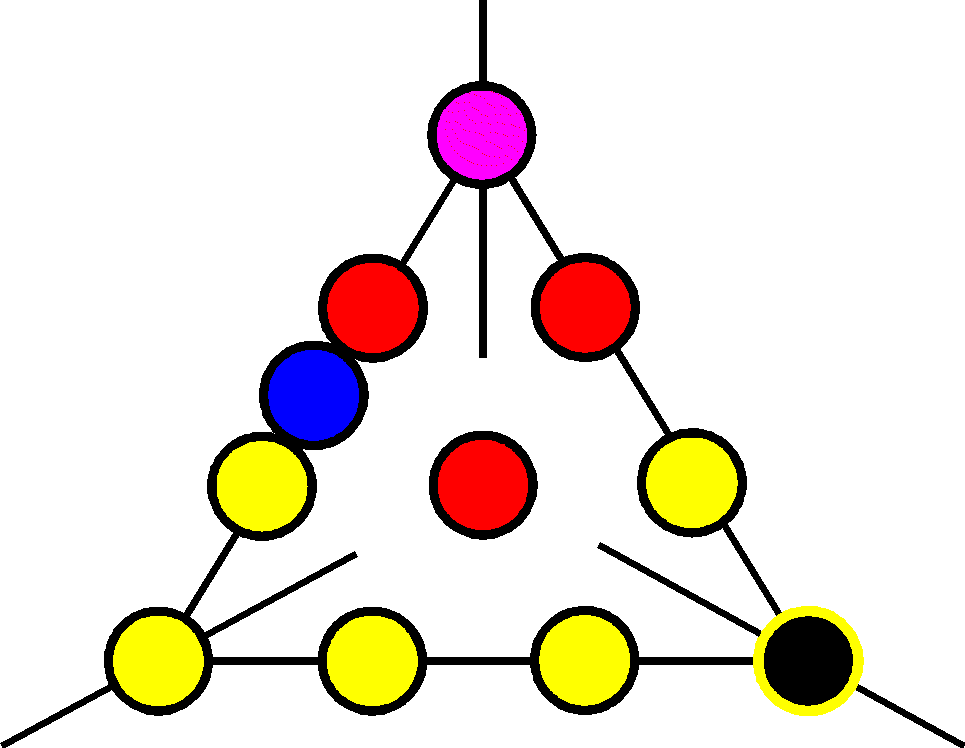

 Mayan
stargazer. For better or for worse, Mayan
Venus horoscope dealt with propitious times to wage war.
Mayan
stargazer. For better or for worse, Mayan
Venus horoscope dealt with propitious times to wage war.



 3rd-4th
century BC. Circled five point star coin or a talisman.
3rd-4th
century BC. Circled five point star coin or a talisman. Pythagorean
pentacle has a single ring but then the
pentacle is enhanced with a second right-angle ring making it a piece
of jewelry.
Pythagorean
pentacle has a single ring but then the
pentacle is enhanced with a second right-angle ring making it a piece
of jewelry.


 Still,
beading around the periphery in the pentacle drawing on the left
invokes a better representation of the pentacle's rotation. 64
beads would nicely show the number of years for the star to rotate
around the Zodiac. Without the actual reference to the earth year,
the number of beads around the periphery could also be 39.27
if you want to show ("point out") the rotating aphelions as
they happen.
Still,
beading around the periphery in the pentacle drawing on the left
invokes a better representation of the pentacle's rotation. 64
beads would nicely show the number of years for the star to rotate
around the Zodiac. Without the actual reference to the earth year,
the number of beads around the periphery could also be 39.27
if you want to show ("point out") the rotating aphelions as
they happen. More
recent crop circles are geometric for the geometry sake and do not
reveal much. They even "abandoned" the circle-square
emphasis. I think the circle makers (okay, ETs), are smarting up from
our quick adaptation of their geometry to our own needs. There is a
nice example of this from the Barbury Castle
More
recent crop circles are geometric for the geometry sake and do not
reveal much. They even "abandoned" the circle-square
emphasis. I think the circle makers (okay, ETs), are smarting up from
our quick adaptation of their geometry to our own needs. There is a
nice example of this from the Barbury Castle 






 Earth
has an orbit interlock with Mars as well. This orbit ratio is 15:8
and it is the ratio of two notes of the musical octave. You will need
to find two notes of the octave that, once put in a ratio, will yield
the musical frequency ratio of 15:8. It is a ratio of two notes and
that means they need to be played together. Why do these two numbers
make a harmonious and pleasant sounding ratio? There are some
mysteries left to be pursued and this is answered in the book. The
fact that you and your friend agree that this ratio sounds harmonious
is perhaps another mystery -- but there is no reason the human brain
would not inherently differentiate harmonious (pleasant) and
disharmonious (unpleasant) sounds [we are, really, put together
rather well].
Earth
has an orbit interlock with Mars as well. This orbit ratio is 15:8
and it is the ratio of two notes of the musical octave. You will need
to find two notes of the octave that, once put in a ratio, will yield
the musical frequency ratio of 15:8. It is a ratio of two notes and
that means they need to be played together. Why do these two numbers
make a harmonious and pleasant sounding ratio? There are some
mysteries left to be pursued and this is answered in the book. The
fact that you and your friend agree that this ratio sounds harmonious
is perhaps another mystery -- but there is no reason the human brain
would not inherently differentiate harmonious (pleasant) and
disharmonious (unpleasant) sounds [we are, really, put together
rather well].
 carefully
decomposed. For example, one of the indigenous names for Hunab Ku is
(the) Galactic Butterfly. You may go off on tangents here with all
kinds of symbology (thinking of the dual line as a butterfly
antenae), but, as a Pythagorean you'll stick to geometry and figure
out that the two heptagons are free to pivot about a common axis in a
butterfly resembling action. Hunab Ku has the real-virtual duality on
the atomic level and their transitions via the diagonals. It has
subtle even-odd symmetry interplay and conveys 3D modulation aspects.
If you get serious on this subject you want to be as authentic as
possible. Almost all Hunab Ku pictures on the Internet are colorless
and the heptagons taken out -- and that just about destroys your
ability to understand it. When traveling in the virtual domain (of
the hyperspace), you kinda jump from here to there in the zig-zag
fashion -- and so I'd also see it as being the Galactic Butterfly.
carefully
decomposed. For example, one of the indigenous names for Hunab Ku is
(the) Galactic Butterfly. You may go off on tangents here with all
kinds of symbology (thinking of the dual line as a butterfly
antenae), but, as a Pythagorean you'll stick to geometry and figure
out that the two heptagons are free to pivot about a common axis in a
butterfly resembling action. Hunab Ku has the real-virtual duality on
the atomic level and their transitions via the diagonals. It has
subtle even-odd symmetry interplay and conveys 3D modulation aspects.
If you get serious on this subject you want to be as authentic as
possible. Almost all Hunab Ku pictures on the Internet are colorless
and the heptagons taken out -- and that just about destroys your
ability to understand it. When traveling in the virtual domain (of
the hyperspace), you kinda jump from here to there in the zig-zag
fashion -- and so I'd also see it as being the Galactic Butterfly. Many
Mayan concepts such as the tribes (I call 'faces,'
others 'kin') were redrawn to look cute. This could be seen
as continuation of reduction, if not erasure, of the Mayan culture.
I'd call this face 'The Little Sphinx:' Love to hear your
interpretation(s). Power of this face is in the logic of its details.
For example, there is a reason the "eyes" are not little
rings like the "mouth." The double vertical line is very
revealing as well but is reduced into a single line in some renditions.
Many
Mayan concepts such as the tribes (I call 'faces,'
others 'kin') were redrawn to look cute. This could be seen
as continuation of reduction, if not erasure, of the Mayan culture.
I'd call this face 'The Little Sphinx:' Love to hear your
interpretation(s). Power of this face is in the logic of its details.
For example, there is a reason the "eyes" are not little
rings like the "mouth." The double vertical line is very
revealing as well but is reduced into a single line in some renditions.

 This
symbol, while associated with Venus, is about the diagonal that is
transformation. The idea, then, is to look to Venus for her
transformative qualities. In general, a transformation deals with the
exchange of real and virtual energies. As such, transformations can
be personal or can deal with free energy extraction, Martial arts,
space travel, or new computational modalities.
This
symbol, while associated with Venus, is about the diagonal that is
transformation. The idea, then, is to look to Venus for her
transformative qualities. In general, a transformation deals with the
exchange of real and virtual energies. As such, transformations can
be personal or can deal with free energy extraction, Martial arts,
space travel, or new computational modalities.
 The
Mesoamerican Venus symbols appear to be based on the number eight
but the symbols make quite a distinction between the cardinal and
semi-cardinal directions.
The
Mesoamerican Venus symbols appear to be based on the number eight
but the symbols make quite a distinction between the cardinal and
semi-cardinal directions.


